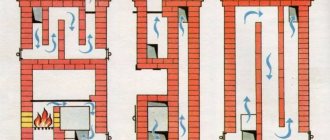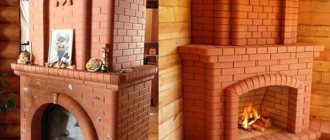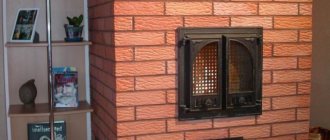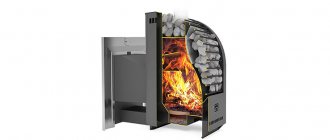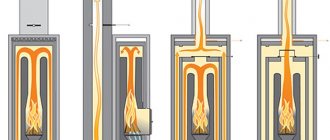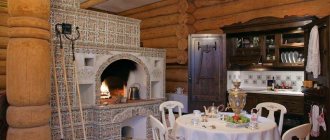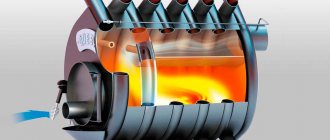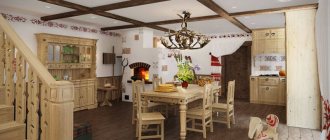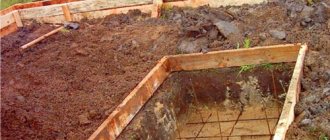The housekeeper stove is essentially a modified concept that is familiar to everyone - Russian. The difference lies in the combustion chambers; if the Russian device has one chamber, then the housekeeper is conventionally divided into two halves: one of them consists of 2 heating chambers of different sizes. The upper part has a kitchen stove and a vault. From this article you will learn how to build it yourself, based on the drawings and recommendations of experts. You will also be informed about the main functions and technical characteristics of fireboxes.
Device and functions
Depending on the thickness of the seams, the dimensions are approximately 1400 * 890 * 2240 mm. Outstanding features are the ability to warm up over the entire height, starting from the floor. The temperature spread will be only a few degrees. In addition, there is an attempt to implement several advantages at the same time.
The presence of a cooking chamber is like in an ordinary Russian one - two fireboxes of different power, a cast-iron stove, ventilation and moderate dimensions. For cooking, use the crucible and both fireboxes. Moreover, the first one is used in the summer, avoiding unnecessary heating of the room. The greatest thermal efficiency is achieved when using the main firebox, and the second firebox can be heated or heated. You can install a water heating box, the device will change.
Firebox
To test fire the stove, fill the firebox completely with dry wood, open the firebox door, the ash pan door and the ash pan doors. The air damper is also open.
We light the firewood, after the large logs begin to burn normally, close the doors and ash pans and check the performance of our homemade “Housekeeper”. Do not use firewood with a humidity level above 20% - this will lead to frequent cleaning of the chimney from a thick layer of soot.
To clean the pipe, use a cable with a brush attached. By passing one end into the chimney. Having brought it outside in the firebox, simply stretch the brush along the entire length of the pipe. But before this operation, we recommend removing or covering things and furniture with film. This operation will have to be performed at least once every 30 days.
When doing work with your own hands, treat it with full responsibility. Comfort and coziness in your home depends on this.
Main differences
Both lower combustion chambers (2 and 3) have their own grates and doors, above them there is a cast-iron plate (5), with concentric rings. Combustion products move along the path: a small firebox, a large one, after the heating and cooking chambers. Access to the space, called the pole, is open from two sides. The hanging corner of the over-pipe is supported on a support made of an angle or pipe (11). To strengthen the outer pole, a metal corner is used, which is called earthenware (4 and 10). A 25th corner of 3 mm thickness is used, which, like the doors, it is advisable to wall up in the seams using wire. The cooking space can be closed with a damper (12) with a handle.
On the front side there are valves to close the smoke and ventilation ducts in the pipe. The latter begins above the hearth, making it possible to remove odors arising above the stove and ventilate the room. The heating cavity is divided into two sections. The partition (16) consists of 3 separate columns, forming the so-called undercuts (20), measuring 12 by 21 cm and a solid wall. The hot smoke, passing through both sections, cools down and exits into the hearth slot (15), into the cooking space. Passing and heating it, the gases move to the forehead, where they go into the pipe.
Features of operation
If the housekeeper stove operates in the proper mode, this will ensure its long service life and efficient performance of its main task.
The stove is not designed for simultaneous operation of both fireboxes. The firebox door must be closed when not in use. You should not allow ash to accumulate; it is better to make it a rule to clean the ash pan before each kindling.
To cook food, you do not need to wait for the wood to burn completely, but you should not start immediately after kindling. You need to wait until the oven warms up, this usually takes about 10 minutes. Another rule that applies to all stoves is to periodically check the condition of the masonry for the absence of cracks and crevices. If these recommendations are followed, Podgorodnikov’s stove will provide high-quality heating for a small house.
Ordinal masonry plan
In the first layer, the bricks along the perimeter are taken whole, but the middle can be filled with halves and broken bricks.
In the second, partition columns, cleaning windows and a vent for the larger firebox should be installed. It is better to trim the lower edges at the exit of the ash pan for ease of cleaning.
Third layer - the door of the filled ash pan and the door are installed. To increase the volume, you can lay the ash pan of a small firebox, or you can do this in the next row. (cleaning doors are not shown on the diagram)
The fourth is installing a small firebox door. We block the cleaning holes. If you decide to replace the doors, leave the windows open until the end of the masonry. At the end of the work, you can finally clean the remaining clay and lay it in the protruding halves. It will be easy to find the holes using the protrusions.
Fifth - the barrier of columns becomes solid and connects to the walls. The door of the large blower is covered, and the perimeter of the large blower is reduced before installing the grate. At this point, under the partition, there should be openings through which smoke will flow from the first section to the second. To increase the mass accumulating heat inside, the partition is lined with bricks lying lengthwise and crosswise.
The sixth layer will be laid on all the grates, and they will overlap slightly. It is advisable to make the front and rear overlap of the small grate beveled, this can be seen in the diagram. Thus, the coals will roll towards the center, which will make it easier for even wet wood to burn in a small firebox.
In the seventh, a large door is installed, and in the 8th, a small one is installed, and with the help of cut ribs, an expansion of the chimney is formed towards the heating partition.
In the ninth, the outlet from the firebox narrows, hanging over the previous river.
In the next step, the exhaust path is blocked from above, along with half of the heating chamber. In fact, this is the first layer of the double bottom of the crucible itself. We leave the gap open, through which the smoke will enter the cooking area. It will stretch from one wall to the other, and will be a quarter wide. The side section shows that the underside consists of two layers laid flat. It is supported by the masonry above the folds. When using it for cooking, it should be heated like a Russian one, cleaning the underside if necessary. If the main firebox is lit, the cooking chamber and stove can be used. It is noteworthy that a smaller firebox burns fuel more energetically, while being less demanding on it.
Next, you can block the firebox doors and lay a second solid layer, leaving a gap.
12 – place the cast iron plate on a thin layer of clay, and strengthen both edges of the pole with a metal corner. Conditional “cheeks” are laid.
The 13th and 14th are completely unsophisticated, the linkage is being made. In the next step, for reinforcement, tapes or wires with washers or threaded ends at the ends are laid in longitudinal layers along the edge. The forehead itself is covered with a metal corner, and not with an arch for simplicity. The lower ribs, which form a narrowing, can be trimmed off.
The 16th is laid in the same way, but this time the reinforcement is done across, and the forehead is overlapped along the metal. The second row of narrowing lies rough.
17 - very similar to 15 and also has a metal fastener. The top “faience” is installed on a pipe or other support. When starting to design the vault, it is easier to start laying it at an angle rather than cutting off each edge. The shape itself should be chosen as a dome, due to its geometric strength. At the same time, it is still advisable to strengthen the supports of the vault by laying additional rods or tape, like the sixteenth. Fill the voids remaining between the wall and the dome with adobe, consisting of thick clay mixed with fragments and sand.
This is exactly how it is recommended to lay the 18th row. Under the tray side of the first stones of the vault, adobe is also laid, and the first units are laid on the metal reinforcement of the cross-pipe.
The 19th closes the vault, but retains four or more openings that subsequently flow into the collection path of the 20th. He is the mentioned collecting channel and narrowing of the over-pipe. Its width is reduced from 25 cm to 18 cm, and the right corner is laid with a lock.
In the 21st, the prefabricated one takes on a form that unites it with the overpipe. A ventilation hole of 7 by 25 cm is immediately laid.
In the twenty-second, the section decreases, it is better to cut off the ribs. The ventilation duct becomes half a brick.
23 – there is a shift to the rear wall.
24 – the ventilation valve is installed.
25 and 26, prefabricated, narrows and turns into a smoke one.
27 – smoke valve.
28 – paths are being merged.
29 – the ventilation part is covered with metal strips.
30 – 33 a three-row plug is placed above the ventilation duct, in accordance with fire safety requirements. The chimney acquires a cross-section the size of a brick.
The profile of the latter goes up to the ceiling, after which a fluff is arranged to pass through the ceiling. The wall thickness of the fluff can be no less than one and a half bricks and rise above the level of the attic floor by 25-30 cm. The pipe can be extended from other materials, but be sure to use fireproof insulating materials. I would like to warn you about the presence of orders on the network that have errors. You should first understand the logical compatibility of the entire masonry.
Construction
The Russian housekeeper stove is not the simplest device, but it is quite accessible for DIY construction. A high-quality order with a description of each step will allow even a novice master to complete all the work without any problems. The difficulty is to understand how the stove works, the features of the device, and the purpose of each component. The 4th generation Podgorodnikov furnace is complicated only by the fact that a chamber with bottom heating appears in the path of gases. In other respects, the circuit diagram corresponds to the classics. The key elements include a small firebox, a large firebox, an ash pan, grates, cleaning doors, a hob, a vault, and under.
The ordering scheme is not difficult to find in an accessible form. There are ready-made projects in which all the preparatory stages are described, calculations and financial costs are made. It should be noted that there are several options for constructing a heated house. They have minor differences, but the project cannot be disassembled, since the circuits are not interchangeable.
Ordinal laying of Podgorodnikov's stove
- Row 1 is the base of the future oven. It is enough to cover only the outer perimeter with facing bricks. The inside can be filled with halves or smaller pieces of red brick.
- Row 2. The outer walls are performed with mandatory dressing. You can observe the appearance of the channels of the lower chamber. The resulting opening will be used to install the blower door.
- Row 3-4. Since the project was created on the basis of the author’s rich experience, all design features are determined by a certain theory. It is not always appropriate to provide this theory in a project. So, for certain reasons, some corners in the channel of the lower chamber are made rounded. A zone is separated that will act as an ash pit.
- Row 5-7. Preparations begin to block the canal. In row 7 it is already blocked.
- Row 8. The wall is tilted by cutting off the edges of the bricks located above the ash pit. The grate is installed. It is important to take into account the thermal expansion of the metal, so you should leave a small gap between the grating and the masonry.
- 9 row. In the back of the firebox, the bricks also have hewn edges. This procedure is performed so that the fuel, after loading, is distributed on the grate. Doors are being installed.
- Row 10-12. The water-heating box is closed, and the walls of the cooking chamber begin to form, creating a large firebox.
- Row 13-16. The cooking chamber has a characteristic arch. It is made of bricks laid on edge. The inward tilt is provided by small brick wedges.
- Row 17. The construction of the vault is being completed. For more convenient work, formwork can be installed before forming the arch. If it cannot be removed after completion of the work, it will burn safely during the first kindling.
Good to know: How a convection oven is used to heat a house, what types it comes in
The formation of the chimney does not require comments, so we will not describe these steps.
Foundation
The integrity and strength of any structure largely depends on the foundation. As in most cases, it should be laid under it to a depth of about 50 cm. The dimensions are increased by 10-25 cm on each side and standard layers are filled. Sand, crushed stone and crushed with a rammer, spilling with water. Filling with cement with rubble stone or other filler. Dry and hard soil will allow the use of more intact bricks and chips, provided there is good waterproofing. If the soil is pliable, then a more rigid base is needed, possibly with reinforcement.
Some rules for making a stove
To ensure that the stove turns out well and lasts a long time, before building it, consider:
- the materials you use must be of high quality. By skimping on high-quality components, you risk providing yourself with long and frequent repairs;
- However, it is better to use the instructions for making the stove. The experience of the master will protect you from mistakes and unnecessary expenses during construction;
- the first time after construction, be especially careful - you might not keep track of something during the work. Other problems may only become apparent during operation;
- follow safety precautions. You can get injured during construction. Be careful and don't take risks.
In general, the stove is quite safe for the home and its inhabitants. Spontaneous combustion from a spark or fallen coals is virtually impossible, even if the stove is used incorrectly. And even a beginner can handle the kindling - the stove is very simple.
Materials
The composition of the mortar on which the masonry will be laid cannot be underestimated. Naturally, the easiest way is to buy a proven dry mixture for masonry. But if you are forced to save, you will have to study ways to determine the fat content of clay and the mixtures necessary for masonry. Don't miss the fact that you will need three different formulations:
- Durable, heat-resistant using fireclay, in the area of fireboxes.
- Moisture-chemical resistant, lime for smoke passages and pipes.
- Durable and at the same time elastic, clay for the base.
Methods for determining the fat content of clay by dried balls, the degree of sticking on a stick, or by throwing cakes are easy to find on the Internet. The thickness of the seams should be within 3 - 4mm. The masonry will be more stable, and the solution will have much less chance of crumbling.
Brick should also be given its share of attention. Not every clay one is suitable. In short, a truly suitable one can be determined visually by the way it is produced.
Recommendations for using a small stove
In order for the stove to be useful and save money, it is necessary to monitor its condition. Even a minor crack increases the loss of efficiency. For better heating, use only dry wood for kindling. Be sure to close the view.
Major cleaning of soot is carried out once - in the summer; in winter, minor cleaning is done, but at least 3-4 times per season. Accumulated soot reduces the heat output of the device. If the viewer, valves or door are faulty, you cannot light the stove, because they control the draft and help carbon monoxide evaporate.
Despite all the nuances in the construction and operation of a mini-oven, it acts as an excellent heating device and can compete with modern gadgets in the speed and delicacy of preparing many dishes. It’s not for nothing that our ancestors considered the stove to be the soul of the house and placed the structure in the middle of the hut.
Not even a few centuries passed before she returned to us, only in a slightly different form. But its small size is not the main thing, because in terms of its functions and the wonderful atmosphere that is created in every home, the device is very similar to the good old Russian stove.
Molding technologies
- semi-dry pressing
- plastic molding
- slip casting
- raw atmospheric drying, etc.
- We are interested in the second option. It can be distinguished by the expressive marks of cutting raw materials, transverse marks and grooves on the edge called the bed. This molding is similar in appearance to clinker molding. However, it is heavier and more expensive, making it less attractive.
- From clinker you can make a base for a heavy structure or a mini-oven, which will have good thermal inertia.
- At the preparation stage, it is worth sorting the stone by quality, smoothness and integrity. Use all the rejects on the base and lower layers. The spoon surfaces that will be inside the channels can be further processed by grinding off irregularities or protruding small fragments.
- During the installation process, each unit must first be soaked in water for about 20 seconds.
- Of course, places exposed to high temperature loads should be lined with fireclay. These can be the walls of the firebox, the beginning of the smoke channel and the partition. Purchasing fireclay now will not be a problem.
Schemes of potbelly stoves
The main advantage of a rectangular stove
, unlike oval products made from pipes or gas cylinders, lies in a larger heated surface area, so its efficiency will be much greater. The optimal size for a potbelly stove is 800x450x450 mm. A stove of this size will not take up much space and will easily fit even in a small room.
An important difference between the Loginov stove
is the presence of two plates (
reflectors
) in the upper part of the combustion chamber.
Since the path of gas movement
increases, the heat transfer of such a potbelly stove is significantly higher than that of a conventional metal stove.
Advice
. If you need to reduce the size of the Loginov oven, then it is advisable to change only its width. If the length and height of the structure changes, its efficiency may decrease significantly.
Detailed diagram of Loginov's potbelly stove
Using the "Economy"
For predicted results of use you should know:
- You should not light both fireboxes at the same time, since the performance of the larger one can lead to smoking of the smaller one through the stove rings and door leakage.
- If a fire is lit in the main firebox, the small door and the vent should be closed tightly. You will avoid rapid consumption of firewood and will be able to regulate combustion.
- During combustion, the damper must be closed, and when opening, the ventilation valve must be opened. This minimizes the possibility of smoke and gases entering the room.
- Effective use of the “crucible” is possible after a good warm-up. You can put the dishes on the stove after 5-10 hours. For baking, you will need to determine the heating of the surface of the hearth. If a pinch of flour thrown on it turns brown, the temperature is right. White or black color will indicate overheating or vice versa.
Principle of operation
This device works simply:
- put firewood in the firebox and light the stove. Before this, the blowers and air dampers of the chimney are opened;
- heated gases enter the first chamber and pass through the connecting channel into the auxiliary firebox;
- heat flows to the 2-burner cooktop;
- through special openings, gases enter the common chimney channel;
- the flows mix, give off most of the heat to the brick walls and are released into the atmosphere.
The stove hearth is open in front and along the side walls. Thanks to this operating principle, such devices have a number of advantages, the main ones being a high level of performance and fuel economy. Especially in the summer, when only the small combustion chamber is used for cooking.
Varieties of options
During the existence of the Russian stove, quite a lot of variants of its design appeared, which differ from each other in some design features. The first most obvious design element that immediately catches your eye is the type of bed - they come in different sizes or shapes:
- with transverse beds located behind the mouth with a pipe. This is a typical option, which provides two beds at once;
- with a longitudinal type of bed, when it is located behind the firebox. This makes the bed wider, and also provides additional storage space for various equipment.
Obvious differences may be different options for the inflow device:
- the classic inflow is located on one side;
- a firebox with a fireplace allows you to combine a stove with a fireplace, while the fireplace can be brought into another room.
Drying the lined stove
After completing the masonry process, the stove cannot be heated at full capacity immediately, since in this case it will dry unevenly and unsightly stains will appear on the surface of the walls. In addition, the mortar at the seams may crack, and the walls will depressurize.
To prevent this from happening, the oven must undergo a natural drying process for 10 ÷ 12 days. In this case, all latches and doors must be opened. In order to create favorable conditions for drying the furnace structure, in this case, an ordinary electric light bulb of 200 ÷ 250 W can be placed in the cooking chamber for the entire drying time.
After completing the first stage of drying, you can move on to forced measures - start heating the stove with a small amount of firewood, with the smoke valves open, but with the fireboxes closed.
The stove is heated for 7 ÷ 10 days according to a special system: in the first two days only 3 ÷ 4.5 kg of firewood is used for heating, every day adding 1 ÷ 1.5 kg of fuel to the initial amount, and so on throughout the entire forced period. drying.
If, after a long drying period and carrying out a control fire, minor cracks still appear in the seams between the rows of masonry, do not rush to repair them. They need to be monitored during the heating season. During this time, they will either stop in one position or expand a little more. Only after the end of the heating season can repairs be carried out, repairing all the defects that have appeared.
What are they made of?
The materials and tools required to build a housekeeper stove are as follows:
- grate;
- doors for combustion chambers;
- ash doors;
- cast iron platform with two burners;
- chimney damper;
- valve for the ventilation channel;
- fire brick;
- electric drill and removable construction mixer;
- Master OK;
- buckets;
- sieve;
- putty knife;
- level.
In addition to the basic materials, you will also need:
- wire;
- round steel, sheet;
- nuts, washers, nails;
- flood sheets;
- asbestos pipes.
Briefly about the main thing
A small stove for a country house will take up minimal space in the room. Despite its compact size, it has high heat transfer and a more attractive appearance than a “potbelly stove”. Its construction requires a minimum of materials and time.
A small stove structure can be intended only for heating a room. The construction of models is also carried out, in which there is a hob and a niche for an oven or a water tank. For the construction of any of the structures, ceramic and fireclay bricks are used. The construction process begins after selecting or developing a project, preparing the necessary materials and foundation. The masonry itself is carried out using a solution of sand and clay according to a pre-selected pattern.
